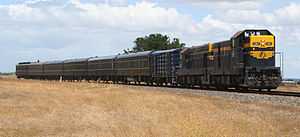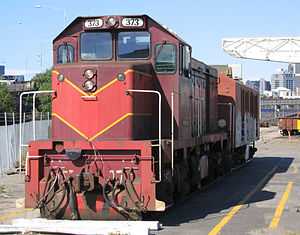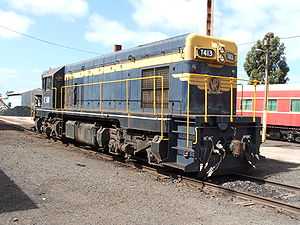Victorian Railways T class (diesel)
| Victorian Railways T class | |
|---|---|
|
Flat top T413 at Newport Workshops in March 2007 | |
| Type and origin | |
| Power type | Diesel-electric |
| Builder |
Clyde Engineering Granville |
| Model | Electro-Motive Diesel G8 |
| Build date | 1955-68 |
| Total produced | 94 |
| Specifications | |
| Gauge |
1,435 mm (4 ft 8 1⁄2 in) standard gauge, 1,600 mm (5 ft 3 in) |
| Fuel type | Diesel |
| Prime mover |
Electro-Motive Diesel 567: T320-T398, T413 Electro-Motive Diesel 645: T399-T412 |
| Performance figures | |
| Maximum speed | 100 km/h (62 mph) |
| Career | |
| Operator(s) | Victorian Railways |
| Number in class | 94 |
| Number(s) | T320-T413 |
| Delivered | 2 August 1955 |
| Preserved | T320, T333, T334, T341, T342, T356, T357, T364, T367, T375, T378, T382, T395, T411, T413 |
| Current owner |
Chicago Freight Car Leasing Australia Pacific National Qube Logistics SCT Logistics Southern Shorthaul Railroad |
| Disposition | 33 in service, 13 preserved, 4 non-rail use, 10 stored, 34 scrapped |
The T class are a class of diesel locomotives built by Clyde Engineering, Granville for the Victorian Railways between 1955 and 1968.
History


In July 1954 the Victorian Railways placed an order with Clyde Engineering for 25 (later extended to 27) diesel electric Electro-Motive Diesel G8 locomotives to partially dieselise country branch lines.[1][2][3][4]
In June 1959 the first of an additional ten entered service. Although mechanically similar to the first batch they differed by having a cab raised above the hood line.[5] A further ten entered service from December 1961.[6]
In September 1965 the first of an order for 32 was delivered. These differed by having a lower nose.[7] A final order for 19 was delivered from April 1967.[8] The last five were built with an extra 10 tonnes (9.8 long tons; 11 short tons) of ballast weight for improved adhesion and low speed controls for use as shunting locomotives in Melbourne. These were reclassified as the H class shortly after being delivered.[9]
In July 1969 an additional flat top unit was purchased second hand from Australian Portland Cement who had ordered it for use at its narrow gauge Fyansford Cement Works Railway, Geelong in 1956. Although outwardly similar to the original T class units it was fitted with dynamic brakes, and became a regular on the steeply graded Cudgewa line.[3]
Although ordered as branch line locomotives, as branch lines began to close they were often used on main line services.
In 1984/85 Martin & King, Somerton rebuilt 13 flat tops as P class locomotives. This involved a new cab and carbody, replacing the EMD 8-567C engine with an EMD 8-645E, replacement of the main generator and traction motors, and provision of a separate head end power generator.[10]
Many were withdrawn in the late 1980s with the arrival of the G class locomotives. In October 1992 six low nose locomotives were sold to Australian National with five entering service as the CK class as shunters and bankers in Adelaide. All were included in the sale of Australian National to Australian Southern Railroad in November 1997. One was resold to SCT Logistics with the remaining four operating on the narrow gauge Eyre Peninsula Railway as at January 2014.[11][12]
Others were sold to Chicago Freight Car Leasing Australia, El Zorro, Great Northern Rail Services, SCT Logistics, Southern Shorthaul Railroad, and West Coast Railway. A number of T class have been preserved.[13]
Those remaining with V/Line Freight were included in the sale to Freight Australia and in 2000 some stored examples were reactivated and fitted with standard gauge bogies to haul grain services in southern New South Wales.[14] These passed with the Freight Australia business to Pacific National in August 2004.
Subtypes
The class can be divided into three main styles by appearance:
- Flat tops: T320-T346 (first order). Based on Electro-Motive Diesel G8 locomotive design, this order had a low cab and roof.[3][15]
- High cabs: T347-T356 and T357-T366 (second and third orders). They differed from the flat tops by having a high cab but were mechanically similar. The 3rd order had an altered radiator design.[5][6][16][17]
- Low nose: T367-T398 and T399 to T417 (fourth and fifth orders). The fourth order introduced a new low nose that provided greater driver visibility, and a more modern generator. The fifth order introduced the newer EMD 645E engine, replacing the older EMD 567 used before.[7][8][18][19][20][21]
- T413: Built in 1956 for the narrow gauge Fyansford Cement Works Railway, Geelong as D1, it was sold to Victorian Railways, renumbered T413 and had its footplates replaced with similar ones to those already on their pre-existing Ts.
- T414: Built in November 1956 as DE02 for BHP, was used at their Iron Knob and Whyalla Steelworks. Was not included in Morrison-Knudsen rebuild program like the rest of the class. In 2006 it was sold to SCT Logistics and rebuilt with a cab similar to those on the fourth and fifth generation Ts, and renumbered T414.[23][24]
References
- ↑ "And now the T’s" Victorian Railways Newsletter October 1954 Page 3
- ↑ The T-Class Diesel-Electric Locomotives Abbott, RL Australian Railway Historical Society Bulletin, September 1972 pages 169-175
- ↑ 3.0 3.1 3.2 1st Order (27 locos): T320-T346 & T413 (1 loco) Mark Bau's VR website
- ↑ Oberg, Leon (1984). Locomotives of Australia 1850 -1980s. Frenchs Forest: Reed Books. pp. 223–224. ISBN 0 730100 05 7.
- ↑ 5.0 5.1 2nd Order (10 locos): T347-T356 Mark Bau's VR website
- ↑ 6.0 6.1 3rd Order (10 locos): T357-T366 Mark Bau's VR website
- ↑ 7.0 7.1 T367-T398 (32 locos) Mark Bau's VR website
- ↑ 8.0 8.1 (14 locos): T399-T412 Mark Bau's VR website
- ↑ 9.0 9.1 H class diesel locomotives Mark Bau's VR website
- ↑ P Class Railpage
- ↑ CK Class Railpage
- ↑ CK Class Vicsig
- ↑ T Class Vicsig
- ↑ "Freight Australia reaches Cowra" Railway Digest August 2000 page 34
- ↑ T Class (T320-T346, T413) Railpage
- ↑ T Class (T347-T356) Railpage
- ↑ T Class (T357-T366) Railpage
- ↑ T Class (T367-T386) Railpage
- ↑ T Class (T387-T396) Railpage
- ↑ T Class (T397-T406) Railpage
- ↑ T Class (T407-T412) Railpage
- ↑ H Class (Vic, Diesel-Electric) Railpage
- ↑ T Class (T414) Railpage
- ↑ BHP / Onesteel / Arrium Whyalla Diesel Locomotives Minnipa Siding
| ||||||||||||||||||||||||||||||||||||||||||||||||||||||||||||||||||||||||||||||||||||||||||||||||||||||||||||||||||||||
